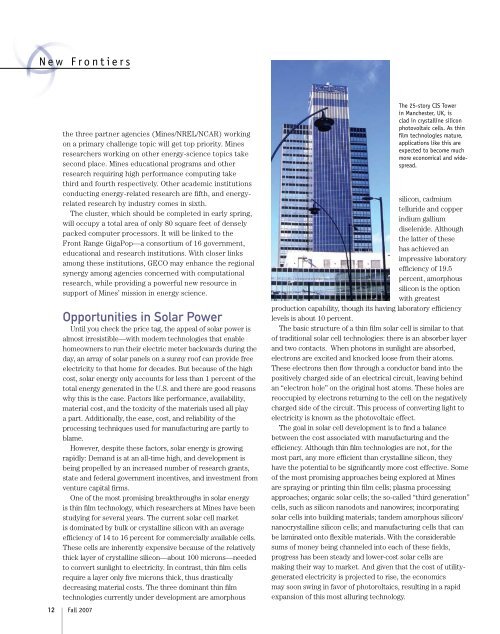New Recreation Center Challenges Students to Greater Heights ...
New Recreation Center Challenges Students to Greater Heights ...
New Recreation Center Challenges Students to Greater Heights ...
Create successful ePaper yourself
Turn your PDF publications into a flip-book with our unique Google optimized e-Paper software.
<strong>New</strong> Frontiersthe three partner agencies (Mines/NREL/NCAR) workingon a primary challenge <strong>to</strong>pic will get <strong>to</strong>p priority. Minesresearchers working on other energy-science <strong>to</strong>pics takesecond place. Mines educational programs and otherresearch requiring high performance computing takethird and fourth respectively. Other academic institutionsconducting energy-related research are fifth, and energyrelatedresearch by industry comes in sixth.The cluster, which should be completed in early spring,will occupy a <strong>to</strong>tal area of only 80 square feet of denselypacked computer processors. It will be linked <strong>to</strong> theFront Range GigaPop—a consortium of 16 government,educational and research institutions. With closer linksamong these institutions, GECO may enhance the regionalsynergy among agencies concerned with computationalresearch, while providing a powerful new resource insupport of Mines’ mission in energy science.Opportunities in Solar PowerUntil you check the price tag, the appeal of solar power isalmost irresistible—with modern technologies that enablehomeowners <strong>to</strong> run their electric meter backwards during theday, an array of solar panels on a sunny roof can provide freeelectricity <strong>to</strong> that home for decades. But because of the highcost, solar energy only accounts for less than 1 percent of the<strong>to</strong>tal energy generated in the U.S. and there are good reasonswhy this is the case. Fac<strong>to</strong>rs like performance, availability,material cost, and the <strong>to</strong>xicity of the materials used all playa part. Additionally, the ease, cost, and reliability of theprocessing techniques used for manufacturing are partly <strong>to</strong>blame.However, despite these fac<strong>to</strong>rs, solar energy is growingrapidly: Demand is at an all-time high, and development isbeing propelled by an increased number of research grants,state and federal government incentives, and investment fromventure capital firms.One of the most promising breakthroughs in solar energyis thin film technology, which researchers at Mines have beenstudying for several years. The current solar cell marketis dominated by bulk or crystalline silicon with an averageefficiency of 14 <strong>to</strong> 16 percent for commercially available cells.These cells are inherently expensive because of the relativelythick layer of crystalline silicon—about 100 microns—needed<strong>to</strong> convert sunlight <strong>to</strong> electricity. In contrast, thin film cellsrequire a layer only five microns thick, thus drasticallydecreasing material costs. The three dominant thin filmtechnologies currently under development are amorphous12 Fall 2007The 25-s<strong>to</strong>ry CIS Towerin Manchester, UK, isclad in crystalline siliconpho<strong>to</strong>voltaic cells. As thinfilm technologies mature,applications like this areexpected <strong>to</strong> become muchmore economical and widespread.silicon, cadmiumtelluride and copperindium galliumdiselenide. Althoughthe latter of thesehas achieved animpressive labora<strong>to</strong>ryefficiency of 19.5percent, amorphoussilicon is the optionwith greatestproduction capability, though its having labora<strong>to</strong>ry efficiencylevels is about 10 percent.The basic structure of a thin film solar cell is similar <strong>to</strong> tha<strong>to</strong>f traditional solar cell technologies: there is an absorber layerand two contacts. When pho<strong>to</strong>ns in sunlight are absorbed,electrons are excited and knocked loose from their a<strong>to</strong>ms.These electrons then flow through a conduc<strong>to</strong>r band in<strong>to</strong> thepositively charged side of an electrical circuit, leaving behindan “electron hole” on the original host a<strong>to</strong>ms. These holes arereoccupied by electrons returning <strong>to</strong> the cell on the negativelycharged side of the circuit. This process of converting light <strong>to</strong>electricity is known as the pho<strong>to</strong>voltaic effect.The goal in solar cell development is <strong>to</strong> find a balancebetween the cost associated with manufacturing and theefficiency. Although thin film technologies are not, for themost part, any more efficient than crystalline silicon, theyhave the potential <strong>to</strong> be significantly more cost effective. Someof the most promising approaches being explored at Minesare spraying or printing thin film cells; plasma processingapproaches; organic solar cells; the so-called “third generation”cells, such as silicon nanodots and nanowires; incorporatingsolar cells in<strong>to</strong> building materials; tandem amorphous silicon/nanocrystalline silicon cells; and manufacturing cells that canbe laminated on<strong>to</strong> flexible materials. With the considerablesums of money being channeled in<strong>to</strong> each of these fields,progress has been steady and lower-cost solar cells aremaking their way <strong>to</strong> market. And given that the cost of utilitygeneratedelectricity is projected <strong>to</strong> rise, the economicsmay soon swing in favor of pho<strong>to</strong>roltaics, resulting in a rapidexpansion of this most alluring technology.

















